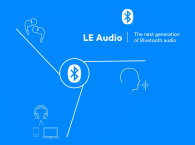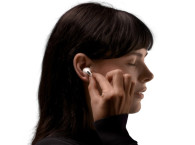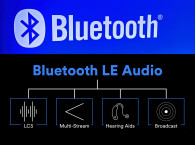At the time, Tempow was working on a breakthrough in Bluetooth technology. We were building a product that could connect one smartphone to multiple Bluetooth speakers from different vendors simultaneously. A challenge that had yet to be solved - it's actually a lot more complicated than it sounds!

Meanwhile, Apple was busy creating the Airpods.
I'll never forget when I tried them out for the first time: blown away. Almost immediately, I realized that these tiny products were setting the bar for a new category of products that would become massive in the years to come. The engineering and development that went into making the Airpods was so sophisticated that competitors have been scrambling to catch up ever since.
A couple of weeks later, we decided to pivot the company from Bluetooth speakers to True Wireless Earbuds (TWE). Since then, the TWE market went from nonexistent in 2016 to 90 million units sold in 2019 and on track to reach 300 million units by 2022.
Here are some of the ways TWE are winning the consumer electronics and notably the hearables market and why they will continue to expand in the years to come.
Voice Control
We' re just at the beginning of what's possible with voice control. Current applications of smart speakers are pretty basic and we still haven't started using the voice assistant like a personal assistant. The earbud is the perfect device to become the link with your assistant. My guess is that Google may be leading this evolution from voice to personal assistant with the Google assistant being more and more on the edge and meant to be used to navigate within Android (open/close apps, read notifications, etc.). However, I believe the market is missing the target when it comes to bringing a personal assistant to your earbuds: everyone is trying to reuse what's been developed for the smart speaker market and embed it into an earbud. But an earbud is not a speaker.
Your smart speaker is a family device, almost another person in your home. Your earbud is a personal device, almost a part of yourself, an extension of your ears. There are two challenges that should be addressed to evolve your earbud into your personal assistant:
- The current "wake word detection engine" ("Alexa" or "Ok Google") won't work with the earbuds. Something needs to be solved around the assistant trigger so that you don't have to address yourself to think out loud.
- The second challenge is that the assistant for earbuds needs to be bidirectional and not unidirectional like a smart speaker. Your earbud assistant needs to be able to talk to you without you asking specifically. And the "assistant notification" question has still yet to be solved.

Hearing Aids
There is a convergence happening between the hearing aid industry and the audio industry. We will soon see the first generation of earbuds, which will never leave the ears, like a hearing aid. It may happen with the earbud form factor. By embedding your earbuds with a hearing enhancement, you could experience augmented hearing or noise-canceling abilities. And some companies are already working on it, like this one: Mimi.
It may also happen with the hearing aid form factor (i.e., as invisible as possible). I listened to music using an , and I was baffled by the audio quality while listening to music - it was excellent.
In both scenarios augmented hearing or enhanced hearing, abilities could soon be integrated in your TWE and could be leveraged in a range of ways from emergency first responders to announcements made on the intercom in public transit. Conversely, noise-canceling also becomes very interesting in cases where better filtering sound and potentially increasing the volume for some specific sounds is important (e.g., the cry of a baby).
Health
If you have a personal health device then it's likely worn around your wrist. But your ear is actually a very interesting touchpoint to collect health data (e.g., body temperature) and particularly data related to your brain.
There is a ton of research on this at the moment, and we see some of the first Kickstarter projects emerging such as these here and here. Apple is also filing several patents at the moment on heart-rate tracking with Airpods and it's only a matter of time before more sophisticated monitoring follows. The next generation of personal health devices will come from the ear, not the wrist.
Battery Consumption
For all of the opportunities TWE present, there is still a key challenge, the elephant in the room that manufacturers and brands are rushing to solve: battery consumption and processing power.
In order to realize all of these use cases, battery consumption must be reduced in order to bring additional components and innovation into the earbud. From where will this innovation come from? At present, chip makers, smartphone OEMs, and audio brands are in an interesting stalemate.
When we pivoted Tempow in 2017, it was because we recognized this need for innovation in TWE. We had the team, the expertise in Bluetooth technology, and even some of the patents needed to solve it... So why not go for it?

Bluetooth LE Audio
Today, Bluetooth Low Energy (LE) Audio is creating new opportunities. In case you missed it, the Bluetooth consortium just announced a new Bluetooth norm at this year's CES: LE Audio.
This new generation of the protocol will significantly improve the performance of Bluetooth Audio and enable a new generation of wireless earbuds capable of substantial optimization from both a technical and user experience perspective. Seizing this opportunity are a new generation of chipset manufacturers embracing Bluetooth Audio, bringing a much welcomed diversity in the landscape with novel approaches and innovations.
At Tempow, we are actively working with some of these chipset manufacturers on a Dual-Mode Bluetooth solution. This will allow us to provide a state-of-the-art software solution that supports both classic and LE Audio during the inevitable transition period brought on by hardware renewal cycles.
Exciting times ahead of us!
* Tempow is a research and design lab based in Paris, France, with extended operations in Seoul, Korea, and Shenzhen, China, focused on pushing the limits of Bluetooth technology.
Update: Tempow was acquired by Google in 2021.
This article was originally published in The Audio Voice newsletter (#263), January 30, 2022.






